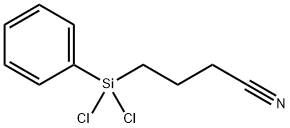Cyanopropylmethyldichlorosilane , 97% , 1190-16-5
CAS NO.:1190-16-5
Empirical Formula: C5H9Cl2NSi
Molecular Weight: 182.12
MDL number: MFCD00019889
EINECS: 214-717-3
| Pack Size | Price | Stock | Quantity |
| 1g | RMB68.80 | In Stock |
|
| 5g | RMB249.60 | In Stock |
|
| 25g | RMB872.00 | In Stock |
|
| others | Enquire |
PRODUCT Properties
| Boiling point: | 79 °C1 mm Hg(lit.) |
| Density | 1.150 g/mL at 20 °C(lit.) |
| refractive index | n |
| Flash point: | 92°C |
| form | Liquid |
| color | Colorless to yellow |
| Specific Gravity | 1.145 |
| Hydrolytic Sensitivity | 8: reacts rapidly with moisture, water, protic solvents |
| EPA Substance Registry System | Butanenitrile, 4-(dichloromethylsilyl)- (1190-16-5) |
Description and Uses
Dichloro(3-cyanopropyl)methylsilane is a versatile silyl halide compound widely employed in scientific research. Its applications encompass its use as a reagent in organic synthesis, a catalyst in chemical reactions, and a fundamental building block for synthesizing various compounds. It exists as a colorless liquid under standard conditions. Dichloro(3-cyanopropyl)methylsilane has been instrumental in synthesizing an array of compounds. Furthermore, it has contributed to the production of polymers such as polyurethanes and polycarbonates. Additionally, Dichloro(3-cyanopropyl)methylsilane has demonstrated its value in the synthesis of peptides and peptidomimetics. Functionally, Dichloro(3-cyanopropyl)methylsilane, being a silyl halide compound, exhibits the characteristics of both a nucleophile and an electrophile in chemical reactions. In its nucleophilic role, it can react with electrophiles like carbonyl compounds to form silyl ethers. Conversely, as an electrophile, it reacts with nucleophiles such as amines to produce silyl amides.
Safety
| Symbol(GHS) |  GHS06 |
| Signal word | Warning |
| Hazard statements | H302+H332-H311-H315-H319 |
| Precautionary statements | P403-P501c |
| Hazard Codes | C |
| Risk Statements | 34 |
| Safety Statements | 26-28-36/37/39-45 |
| RIDADR | UN 2987 8/PG 2 |
| WGK Germany | 3 |
| RTECS | ET9100000 |
| F | 10-21 |
| TSCA | Yes |
| HS Code | 29310099 |
| Toxicity | mouse,LCLo,inhalation,770mg/m3/2H (770mg/m3),"Prehled Prumyslove Toxikologie; Organicke Latky," Marhold, J., Prague, Czechoslovakia, Avicenum, 1986Vol. -, Pg. 1225, 1986. |





